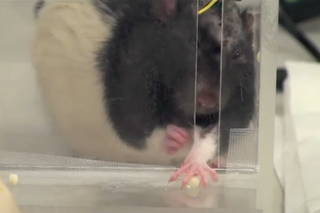New Device Bypasses Destroyed Area in Rat's Brain

A device called a "neural prosthesis" can bypass an injured part of the brain, and connect two distant brain regions, according to new research.
In experiments, the device allowed rats with brain injuries to regain the ability to move their forelimbs, said the researchers who conducted the proof-of-concept study.
The researchers mimicked traumatic brain injury in 16 rats by severing communication across the communication hub between the motor and sensory areas that control the limb movements. The injury made rats largely unable to use their forelimbs to reach and grasp food.
The researchers then used the prosthesis, called a brain-machine-brain interface, to restore communication between the motor and sensory areas. The prosthesis is a microchip connected to microelectrodes that are implanted in the two disconnected brain regions.
The rats eventually regained their ability to reach and grasp food, and two weeks later, their movements were indistinguishable from their behavior before their brain injury, according to the study, published today (Dec. 9) in the journal Proceedings of the National Academy of Sciences. [Video: Brain Prosthetics- Rat's Motor Function Returned to Normal]
"We are essentially using this device to couple activity from another area of the brain that has been spared from injury," said study researcher Pedram Mohseni, a professor of electrical engineering and computer science at Case Western Reserve University in Cleveland, Ohio.
"Our hypothesis was that the new area can take over the function of the injured part of the brain," Mohseni said.
Sign up for the Live Science daily newsletter now
Get the world’s most fascinating discoveries delivered straight to your inbox.
The results suggest that neural interface systems could be used to bridge damaged neural pathways and promote recovery in people suffering from traumatic brain injury or stroke, although much more research needs to be done before this technology could be tested in humans, the researchers said.
"First, the efficacy and safety of this approach should be tested in the brain of primates that is more similar to human brain," Mohseni said.
The researchers will also look at whether the device would have to be implanted permanently, or could be taken out after it repairs the lost connections, Mohseni said.
Brain interfaces have been under investigation in recent years as a treatment for people with brain injuries. In most cases, however, the research involves systems that drive communication between the brain and an external machine (called a brain-machine interface). For example, in one approach, a patient could use her brain activity to control the movement of a robotic arm.
The device in the new study, by contrast, drives communication between brain regions. The device separates neuronal signals produced in one brain region from background noise, and with each spike detected, the microchip sends a pulse of electrical current to stimulate neurons in the second part of the brain, the researchers said.
As a control for the experiment, the researchers also induced the same brain injury in another group of rats, but didn't implant the device. For a third group, a device was implanted, but was stimulating the brain regions randomly. The rats in these groups didn't recover their limb movements as well as the first group, according to the study.
It remains unclear how soon after an injury the device may need to be implanted in order to be beneficial, the researchers said.
"In our current study, we implanted the device as soon as we could, in a few hours after the injury. That model is obviously not clinically viable because you can't expect that a person who just had a traumatic brain injury to have this device implanted in few hours," Mohseni said.
Email Bahar Gholipour. Follow us @livescience, Facebook & Google+. Original article on Live Science.

Most Popular

